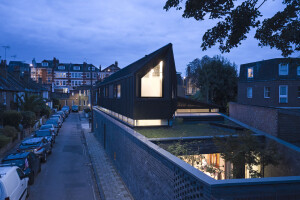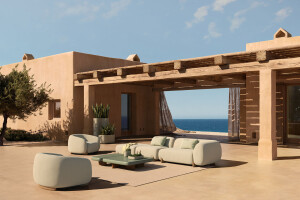Orlando Diaz-Azcuy is a master of subtle gesture and sophistication. His studio in the American city of San Francisco radiates Zen-like tranquillity and his apartment is an oasis of understated style. He was born in Cuba and has been living and working for almost half a century in the United States. Having started out as an architect, he transferred his operations to interior design. And, in that field, he has attained international fame at the top of the market. He received OBJEKT©International in his studio garb (worn by everyone working there): a white laboratory coat.
In 1962 Orlando Diaz-Azcuy left Cuba and sought refuge in Washington DC. All he possessed were, literally, the clothes on his back. He earned his living making drawings for a firm of architects and gained his architecture degree in Washington DC.. He moved to Berkeley, California to, do his masters degree in landscape architecture and city planning. He describes those early years as a struggle. He did not speak the language. Castro had confiscated his father’s business in Cuba: “I had to work here, not only to earn my own living, but also to have money to send to Cuba.” He recalls an odd incident from that time.
“As a draughtsman, I had to draw bathrooms for black and white people. I found that strange, because we didn’t make that distinction in Cuba. Although there was no real difference between the two designs, it did upset me. I did it because I had to, for economic reasons. I still feel guilty sometimes when I look back. I persevered and discovered that, despite everything, this is still a country where dreams can come true. In 1972 I became a US citizen. No, I don’t want to go back to Cuba. There’s no reason, no family and I don’t want to witness the country’s decline. If at some stage my help were to be needed, without Castro, I would go, but I don’t think they need me – there are enough intellectual and creative resources in Cuba. Things should be done by the Cubans who are living there and who have suffered under the current state of affairs. If I can contribute, it’s fine, but not otherwise.”
Although he intended to move to New York, he stayed on in San Francisco, where he worked for several architecture studios, becoming design principal at Gensler and Associates Architects in 1976. When, in the mid-1980s he was voted designer of the year and inducted into the Hall of Fame, he saw the opportunity to start up his own practice. Initially he wanted only to design furniture, but soon he was being asked to create entire interiors. Since then he has had a studio in the heart of San Francisco, in Post Street. “The studio grew apace from then on. At some stage we had 40 people working there. It was time to scale down. I was more of a manager than a designer at that time. The past 15 years we’ve had around 12 designers here, and management is now shared between myself and 2 principals, who undertake most of the business trips. I try only to travel for pleasure.” In 2001 he opened a second studio – in New York. The Internet enables him to work alone there and have the plans drawn up in San Francisco. With his Orlando Diaz-Azcuy Design Associates – Odada – he operates at the top end of the market. “Fortunately or unfortunately – I don’t know which – our clientele is ‘high-end’. These people have always had money to furnish their homes.” Orlando received OBJEKT©International in his studio. He took care to consider his words carefully. Like everyone else in the studio, he was dressed in a kind of white laboratory coat, so as to avoid upsetting the serene ambience. Although a Zen-like tranquillity prevailed, he assured us that people were working hard at their computers. “I’ve always liked clean work. When I decided to concentrate on residential projects, I had a problem to start with, because people identified me with minimalism and hard-edge construction. I had to prove that I didn’t pursue a particular style, but carried the old conviction of architecture: that designers are here to solve problems and then create pleasant, attractive surroundings. Today if someone asks me to make an interior entirely in wood and metal, or a more country atmosphere, I can do it all. In practice, my clients want mainly a more modern, pared-down interior style. However, I never recreate traditional architecture. If I’m asked for an authentic, classical interior, I won’t do it. I’ll assimilate, retaining history and making the interior appropriate for the 21st century. No Buckingham Palace interiors for me – I don’t like them. Above all, it’s our job to look to the future. And when looking to the future, you must respect and preserve the past, but not copy it. You should always be on the look-out for what is new and more experimental”, according to Orlando, who happens to find San Francisco not particularly experimental as a city. He describes it as a place where there was once a large concentration of architects and designers, but that lives in the past today. “In the United States, Los Angeles is at the forefront in architecture. Frank Gehry thrived there: it took ages for a city like New York to accept Gehry’s ideas.” Orlando: “The Netherlands and the Scandinavian countries – those are places where they do experimental things. In America we adopt those ideas and enlarge on them. It doesn’t mean there’s no talent in this country. But there isn’t the clientele to accept the experiments, though there are exceptions, of course.” Miami is in a class of its own. “That city is ‘whatever you want, you can have’. You cannot isolate architecture from things like fashion or theatre. If a city is good at one, it will be good at the other. Miami is blessed with Latin and Cuban influences that changed everything in the nineteen-sixties. The Cubans and Latinos brought music, a new gastronomic culture and sensuality, making Miami more ‘Latin’ than anywhere else in the United States.” When asked if his own work exhibits Cuban influences, he replied cautiously: “I must admit that my early days here were hard. I did my utmost to learn how Americans think and solve their problems. It meant I largely set aside my Cuban roots. What I have done – and perhaps that’s Cuban – is add sensuality to my creations. The celebrated architecture journalist, Stanley Abercrombie, once told me: your work has something special. I think he was referring to a degree of softness and sensuality that my work emanates. You can also see it here in this ‘laboratory for design’, as I call the studio. People are nicer to one another. We work like Trojans, but we do it more gently. Ultimately, there’s always something you retain from your childhood. That probably explains it.” And he continued: “ Some people call me a perfectionist. But I don’t aspire to perfection – I want the best possible solution to a problem. Of course, I like work to be done the best it can, but perfectionism isn’t a goal as such. I want to give my client the maximum I can achieve. I don’t like one specific style. I’ve no objections to combining African masks or Inca artefacts with Italian damask. If something radiates integrity, I can use it.”
He pointed out the large black-and-white diptych in the studio’s conference room. It was made by the Cuban artist, Carmen Herrera, who has reached the ripe old age of ninety. He described the work’s simplicity and freshness as incredible. Carmen was living an working in Paris when artists like Picasso and Braque were active there. “At some stage she came to the United States, but she never had a show here. Until quite recently, when the Museum of Modern Art discovered her work. Now all the museums world wide have her work. She built up a small oeuvre and I feel privileged that I was able to acquire this work not long ago. She told me that although she was born in Cuba, she never felt she was a Latin painter. Latin American paintings are generally very colourful – you can’t say that about this one. The same thing happened with me and I think it has something to do with the urge to look to the future. I’m not referring to science fiction, with odd-looking, three-eyed people, but reality.”
What does he consider essential when designing an interior? Orlando: “When I embark on a design, I must first know about the clients’ emotions and feelings. How they want to live, how they dress and behave. That’s my starting point. When clients come here they have expectations. Often about something they have seen and like. They want exactly what they envisage. It’s my job to discover why they think it’s attractive and what feelings they have about it. Those emotions are my frame of reference, not the picture they bring along with them. We designers have to work very creatively, but not to recreate something. We must shape surroundings that enable people to express their lives in the best possible way.”
“One discussion point in our work is always money. Designers are trained to be creative, but not to manage their creativity. I was fortunate to work at a big practice where I learned to deal with money: to manage time and income properly. That’s another reason why clients seek us out. Whatever you do, you should always keep in mind how you do it. Many designers just design for museums – they don’t design chairs to sit on, but to have on show at the MoMA. That’s their dream and that’s why there is so much uncomfortable furniture on the market. I want to design for people. Designers like Ray & Charles Eames and Philippe Starck have done so too, in their own way.”

































